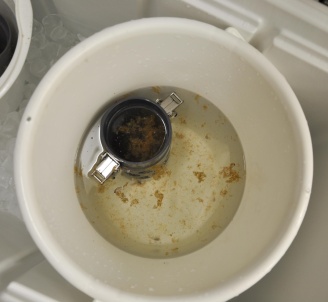Well… remember that plankton can range in size from things that are very, very small, like bacteria, to things that are really quite large, like giant jellyfishes? How we catch plankton depends quite a bit on what type of plankton we would like to catch. It is also important to know that things that are small tend to be very abundant in the ocean, and organisms become more rare as they increase in size. This pattern means that we can usually sample small volumes of water to study small plankton, and we need to sample very large volumes of water to find large plankton. If we focus just on the animals that are in the plankton (and not the smaller things), we usually sample them using a few different ways:

Bongo nets
Using plankton nets. People have been collecting planktonic animals in nets for hundreds of years, and this still remains the most common way of sampling. There are lots of different types of nets, some very simple and some very complicated. Some have very fine mesh and are good for collecting small animals (e.g. copepod nauplii, see posts by Michelle), and some have very coarse mesh and are good for collecting things like shrimp, or small fishes, that really are good swimmers. We have to tow the net quite a bit faster to collect animals that are good swimmers, because they can feel the net coming and and are quite good at escaping!
During the daytime, when there is sunlight on the ocean, they may also see the net coming, and be able to avoid getting caught. We are using two different types of nets on this cruise, and we are towing them in two different ways: (1) vertical tows of a 60 um mesh net to collect copepod nauplii (baby copepods), and (2) oblique tows of a bongo net (see picture), to filter larger volumes of seawater and collect larger animals in the upper ~ 350 m of the ocean. Oblique just means that we are towing the net at an angle (45 degrees), so the net is moving both along in the ocean horizontally as we are pulling it up towards the surface. We can filter more seawater this way, and collect animals that are relatively large and relatively rare. Once we get our nets back in, we rinse them and collect the plankton in our buckets (see picture of the collecting end on the net, which we call ‘cod end’). On this cruise we carefully split the catch of each net using a Folsom Plankton splitter (see picture of me in the lab splitting a sample).
Another way to catch plankton is by using the CTD Niskin rosette. Using the CTD rosette, we are able to collect and study plankton from particular depths in the ocean. This is important, because the ocean changes dramatically across depth, very much more so than across the surface of the sea (horizontally). Animals often like to live only at certain depths, and are very good at maintaining themselves where they would like to be in the water column. Most animal plankton are too rare to sample with a CTD rosette. We are using it to sample copepod nauplii, which are often very much more abundant than the adults.
There are yet other methods, which we don’t use on this cruise. For instance, while scuba-diving. Many planktonic animals are gelatinous, and are therefore very fragile and hard to collect without damaging them. Jellyfishes are one good example, but there are many other types of gelatinous plankton that you might not be familiar with, like ctenophores, or siphonophores (ever been stung by a portuguese man-o-war? that’s a siphonophore). In order to really see these animals as complete organisms, you need to collect them by hand.

